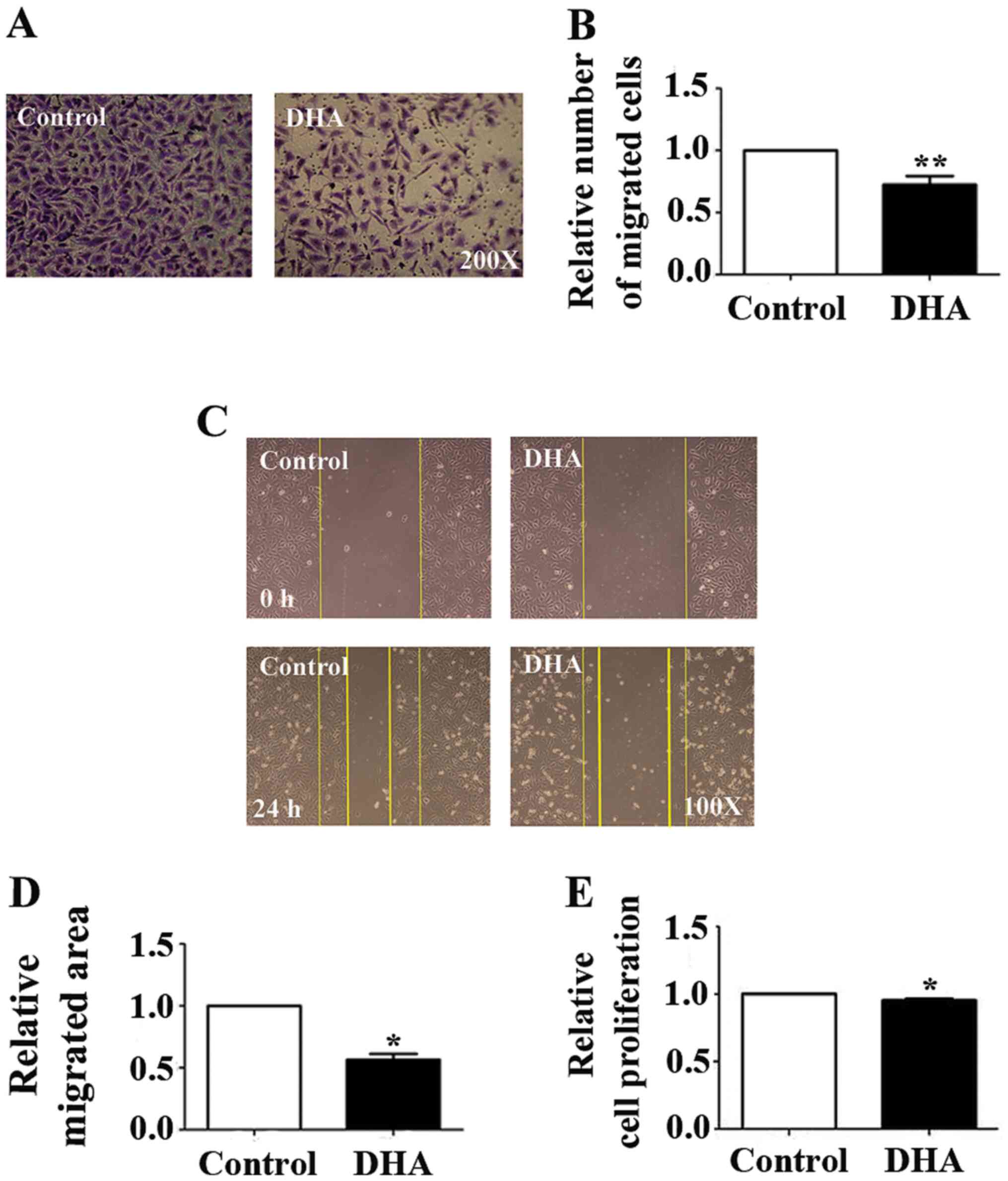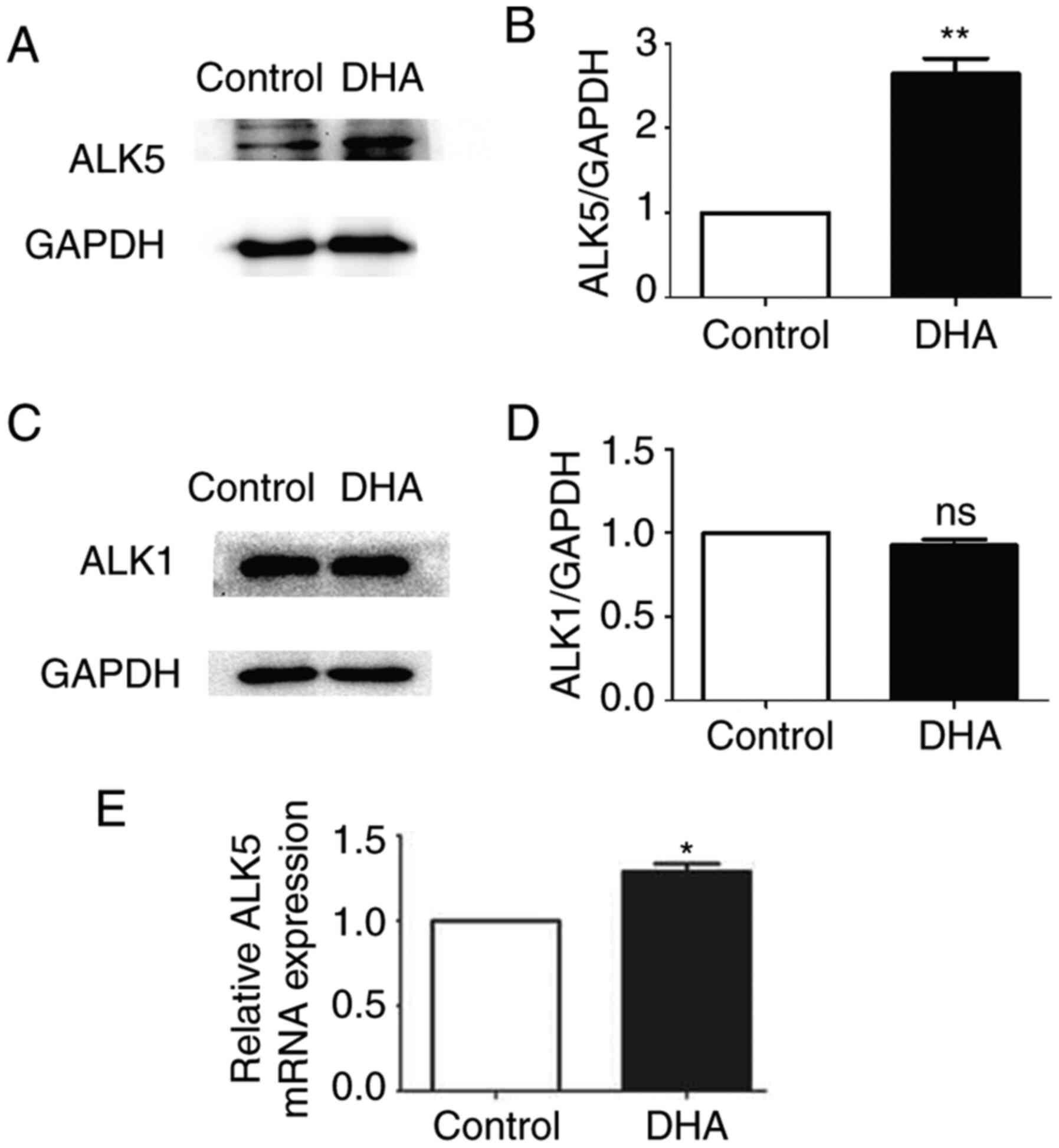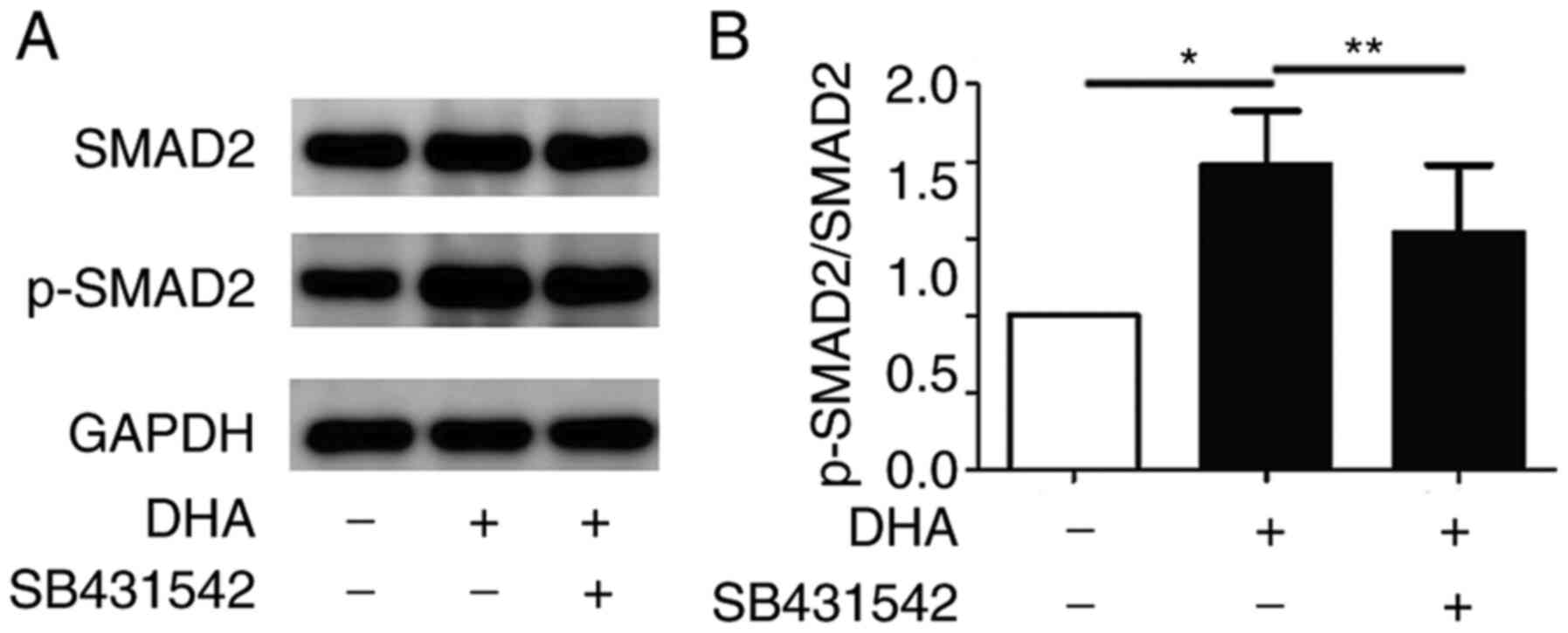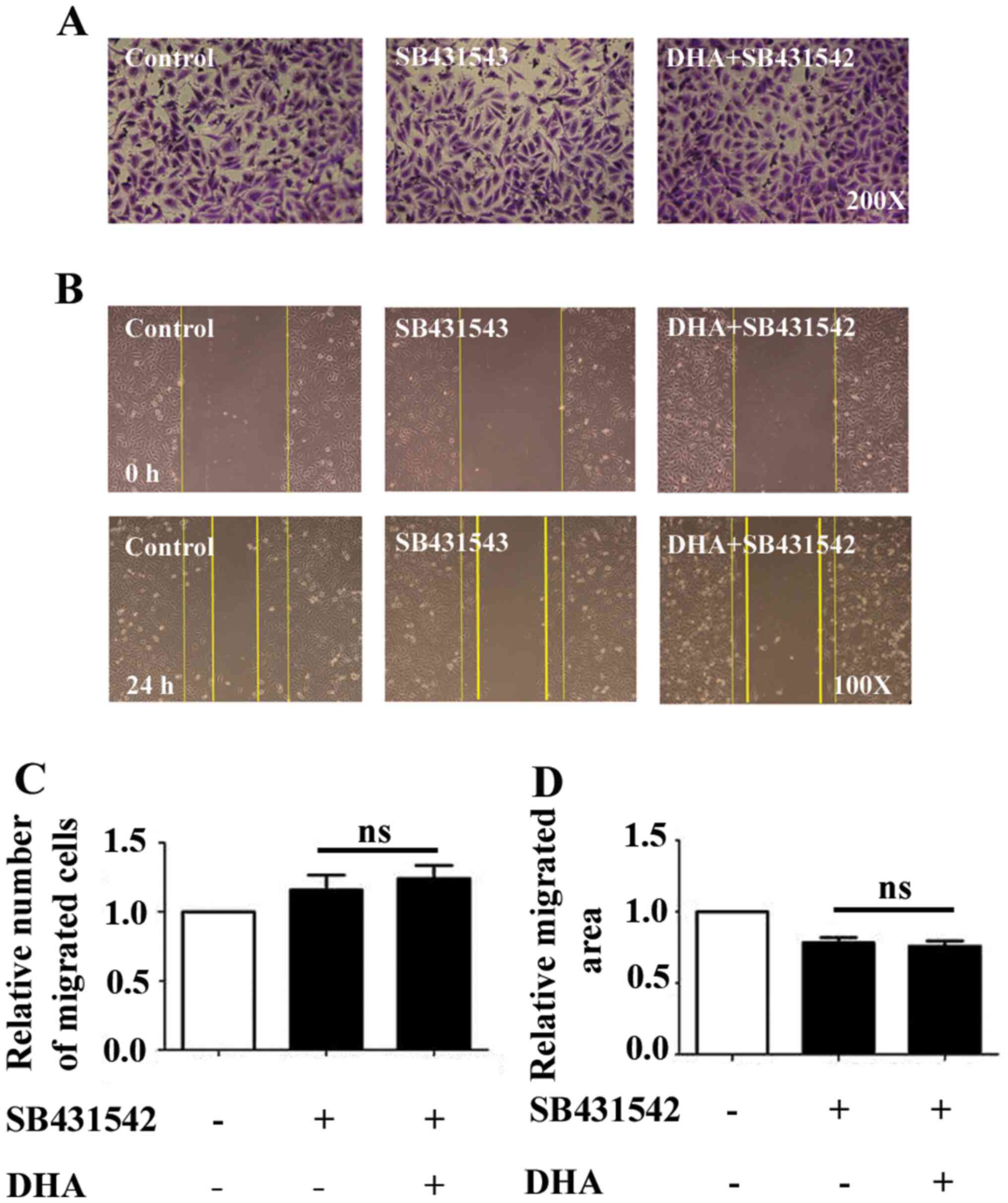Dihydroartemisinin inhibits endothelial cell migration via the TGF‑β1/ALK5/SMAD2 signaling pathway
- Authors:
- Published online on: May 3, 2021 https://doi.org/10.3892/etm.2021.10141
- Article Number: 709
-
Copyright: © Guo et al. This is an open access article distributed under the terms of Creative Commons Attribution License.
Abstract
Introduction
Angiogenesis is a process in which new blood vessels arise from pre-existing capillaries (1). It is not only fundamental to physiological processes, such as the menstrual cycle and wound healing (2,3), but also the basis of the pathogenesis of tumor growth (4). Angiogenesis promotes tumor progression and metastasis (5). Anti-angiogenic therapy has been approved as a novel treatment for malignant tumors, such as medullary thyroid, non-small cell lung, renal cell and metastatic colorectal cancers (5).
Endothelial cell (EC) migration is the basis of angiogenesis (6). In the activation phase of angiogenesis, vascular permeability increases, basement membranes are degraded and ECs proliferate and migrate into the extracellular space and form the new capillary buds. These cells stop proliferating and migrating in the resolution phase, combine to form the basement membrane and facilitate vessel maturation. Finally, surrounding the newly formed vessels, mesenchymal cells are recruited and differentiate into smooth muscle cells and pericytes (1,7).
Dihydroartemisinin (DHA), a derivative of artemisinin, has been identified to exert anti-angiogenic and anti-EC migration effects (8-10); however, the underlying molecular mechanism remains unclear.
TGF-β1 is the predominant and most ubiquitous member of the TGF-β superfamily and serves a pivotal role during angiogenesis (11). TGF-β1 activates two type-I receptors with opposite effects in EC migration. One of the two type-I receptors is called activin receptor-like kinase 5 (ALK5). This phosphorylates SMAD2 proteins, resulting in inhibition of EC migration via the TGF-β1/ALK5/SMAD2 signaling pathway (12). SB-431542, an ALK5 kinase inhibitor, blocks the inhibition of EC migration (13). In contrast to ALK5, activin receptor-like kinase 1 (ALK1), another TGF-β1 type-I receptor, activates SMAD1/5, resulting in EC migration via the TGF-β1/ALK1/SMAD1/5 signaling pathway (12,14).
In the present study, it was hypothesized that DHA could inhibit EC migration via the TGF-β1/ALK5/SMAD2 signaling pathway. Human umbilical vein ECs (HUVECs) were treated with DHA and SB431542, followed by migration assays. The effects of DHA treatment on the TGF-β1/ALK5/SMAD2 signaling pathway were assessed via western blotting.
Materials and methods
Cell culture
HUVECs were obtained from American Type Culture Collection and cultured in Dulbecco's modified Eagle's medium (DMEM) supplemented with 10% fetal bovine serum (FBS; Gibco, Thermo Fisher Scientific, Inc.) and antibiotics (100 IU/ml penicillin and 100 µg/ml streptomycin). The cells were cultured in humidified air at 37˚C with 5% CO2. DHA was obtained from Sigma-Aldrich (Merck KGaA), and SB431542 was purchased from Cell Signaling Technology, Inc. They were both dissolved at 10 mM in dimethyl sulfoxide.
Cell proliferation assay
The anti-angiogenesis effect of DHA is dose-dependent. In our previous study, a concentration of 25 µM or higher of DHA was demonstrated to reduce the growth of HUVECs significantly (15). Therefore, 25 µM of DHA was used in the present study. An MTT Cell Proliferation Assay kit (cat. no. 1009365; Cayman Chemical Company) was used to evaluate cell proliferation. The cells were cultured at a density of 5x103 cells/well in a 96-well plate. The next day, 25 µM DHA was added to the culture medium. Similarly, the control groups were treated with equivalent dimethyl sulfoxide. After 24 h, MTT solution (10 µl; 5 mg/ml) was added to each well, followed by incubation for 4 h. The culture medium was discarded, and dimethyl sulfoxide (150 µl) was added. These steps were all performed at 37˚C. Finally, a 96-well plate reader (Molecular Devices, LLC) was used to analyze colorimetric intensity at a wavelength of 570 nm. Each experiment was repeated three times.
Wound healing assay
Fully confluent HUVECs were starved for 2 h with 2% FBS (a stress growing condition) at 37˚C. Wounds were created across the monolayer of cells by scratching the surface with a sterile pipette tip. Then, 25 µM DHA or 20 µM SB431542 was added to the DMEM supplemented with 10% FBS, a physiological growing condition, in DHA treatment group or SB431542 treatment group, as previously described (16). Similarly, the control groups were treated with equivalent dimethyl sulfoxide. Eventually, images were captured after incubation for 0 and 24 h at 37˚C. ImageJ software 1.4.3 (National Institutes of Health) was used to determine cell migration at the 0 and 24 h time points. Cells were viewed using x100 magnification with a phase-contrast microscope (Olympus Corporation), as previously described (17).
Transwell assay
Briefly, HUVECs (1x105 cells/well) were seeded in the upper chamber in 24-well plates with 25 µM DHA or 20 µM SB431542 in DMEM supplemented with 2% FBS. Similarly, the control groups were treated with equivalent dimethyl sulfoxide. The bottom chambers were filled with 500 µl DMEM supplemented with 10% FBS overnight at 37˚C. After 24 h of incubation, cells that had migrated through the membrane were fixed with 79.2% methanol and stained with 0.1% crystal violet for 30 min at room temperature. Migration was quantified by manually counting the number of stained cells at x200 magnification with a phase-contrast microscope (Olympus Corporation).
Western blot analysis
Western blotting was performed as previously described (17). GAPDH was used as the loading control. The following antibodies were used: Rabbit anti-TGF-β (1:1,000; cat. no. ab66043; Abcam), rabbit anti-ALK1 (1:1,000; cat. no. ab108207; Abcam), rabbit anti-ALK5 (1:1,000; cat. no. sc-398; cat no. F0315; Santa Cruz Biotechnology, Inc.), rabbit anti-phospho-SMAD2 (1:5,000; cat. no. ab188334; Abcam), rabbit anti-SMAD2 (1:5,000; cat. no. ab40855; Abcam), rabbit anti-GAPDH (1:8,000; cat. no. I0494-I-AP; ProteinTech Group, Inc.) and goat anti-rabbit IgG (1:10,000; cat. no. ab150077; Abcam).
Reverse transcription-quantitative (RT-q)PCR
As previously described (18), following the addition of DMSO and DHA, HUVECs were cultured for 24 h. HUVECs were washed twice using ice-cold PBS. The RNAiso Plus kit (Takara Bio, Inc.) was used to extract total RNA. cDNA was generated using a reverse transcriptase kit (ChamQ Universal SYBR qPCR Master Mix; cat. no. Q711-02/03; Vazyme Biotech Co., Ltd.). The total RNA (~1,000 ng), 4 x g DNA wiper Mix (4 µl) and RNase-free ddH2O were incubated for 2 min at 42˚C in A200 Gradient Thermal cycler (Thermo Fisher Scientific, Inc.). After adding 5xHiScriptIII qRT SuperMix into the aforementioned mentioned mixture, cDNA was constructed at 37˚C 15 min and 85˚C for 5 sec. cDNA was amplified using a Taq DNA polymerase kit (Tiangen Biotech Co., Ltd.). The qPCR reaction consisted of three steps: Pre-denaturation (95˚C for 30 sec), cyclic reaction (95˚C for 10 sec; 60˚C for 30 sec; repeated x40) and melting curve (95˚C for 15 sec; 60˚C for 60 sec; and 95˚C for 15 sec). The primer sequences were as follows: ALK5 forward, 5'-GCCGTTTGACTGAAGGCTG-3' and reverse, 5'-GGGCATCCCAAGCCTCATC-3'; and GAPDH forward, 5'-TGATGACATCAAGAAGGTGGTGAAG-3' and reverse, 5'-TCCTTGGAGGCCATGTGGGCCAT-3'.
Statistical analysis
Data were expressed as mean ± standard error (SE). n=3, indicated that each experiment was repeated 3 different times. Densitometric analysis of western blots was performed using Image J software 1.4.3 (National Institutes of Health). An unpaired Student's t-test or one-way ANOVA followed by the Tukey's multiple comparisons test was used for statistical analysis. Statistical analyses were performed using GraphPad Pro Prism 5.0 (GraphPad Software, Inc.). P<0.05 was considered to indicate a statistically significant difference.
Results
DHA reduces EC migration
To verify the effects of DHA on EC migration, Transwell and wound healing assays were performed. The numbers of HUVECs that migrated through the polycarbonate membrane in the Transwell assay were significantly reduced (33.25%; P<0.01; Fig. 1A and B). Furthermore, the area of the wound in the DHA treatment group was significantlyreduced in the wound healing assay (43.42%; P<0.05; Fig. 1C and D). It was also demonstrated that relative cell proliferation was significantly decreased in the DHA-treated groups in the MTT assay (4.70%; P<0.05; Fig. 1E). These data suggested that inhibitory effects of DHA on migration were more significant than those on proliferation.
DHA treatment increases the expression levels of ALK5
In order to examine the activation of two different TGF-β1 type-I receptors in ECs, the protein expression levels of ALK1 and ALK5 were analyzed. The present study revealed significant upregulation of ALK5 protein expression in the DHA treatment group after 16 h of DHA treatment compared with control group (164.31%; P<0.01; Fig. 2A and B). However, ALK1 protein expression remained unchanged in the DHA treatment group (Fig. 2C and D). Additionally, the mRNA expression levels of ALK5 were examined, and DHA treatment upregulated ALK5 expression at the transcriptional level in the DHA treatment group (28.97%; P<0.05; Fig. 2E). These data demonstrated that DHA-induced upregulated ALK5 expression and may not affect the ALK1/SMAD1/5 signaling pathways.
DHA treatment increases SMAD2 phosphorylation
When the TGF-β1/ALK5/SMAD2 signaling pathway is activated, ALK5 phosphorylates SMAD2. The phosphorylated SMAD2 is translocated into the nucleus and activates the expression of target genes (19). Western blot analysis revealed that the levels of phosphorylated SMAD2 in the DHA treatment group were increased following DHA treatment (97.49%; P<0.05; Fig. 3A and B). Additionally, the expression levels of SMAD2 remained unchanged in the DHA treatment group. In the presence of SB431542, the increased levels of phosphorylated SMAD2 due to DHA were partially abrogated in the DHA and SB431542 treatment groups (39.17%; P<0.01; Fig. 3A and B).
SB431542 rescues DHA-induced repression
SB431542 is an effective inhibitor that represses ALK5/SMAD2 phosphorylation (13). In the presence of SB431542, DHA did not inhibit EC migration, and the reduction in EC migration by DHA was rescued in the DHA and SB431542 treatment groups in the Transwell and wound healing assays (Fig. 4A and B). The data demonstrated that the blockade of the TGF-β1/ALK5/SMAD2 signaling pathway mediated the anti-EC migration effects of DHA.
Discussion
Abnormal angiogenesis serves a crucial role in tumor survival, growth, invasion and metastasis (5). Anti-angiogenic agents, such as tyrosine kinase inhibitors, monoclonal antibodies and fusion peptides, are increasingly being used as treatments for certain malignant tumors (20,21). However, the targeting of single angiogenic molecules is insufficient against the countless stimulators produced by tumors and their microenvironment.
DHA has been identified to exhibit remarkable activities, such as inhibiting angiogenesis, and inhibiting tube formation and EC migration (15,17,22). The present study aimed to examine whether DHA inhibited EC migration via the TGF-β1/ALK/SMAD signaling pathway. EC migration is a directional movement caused by chemotactic, haptotactic and mechanical stimuli, and it is an important part of angiogenesis (6). The dynamic and multistep process of EC migration includes cell sensing, extension, attachment, contraction, rear release and recycling movement. The whole process is affected by cytoskeletal recombination, chemokines, extracellular matrix, integrin chemotaxis, mechanical stimulation and signaling pathways (23). In our previous study, DHA exhibited dose-dependent anti-angiogenic effects, and treatment with ≥25 µM DHA markedly reduced the proliferation of ECs (15). Consistent with our previous studies (15,17), DHA treatment in the present study not only inhibited proliferation, but also inhibited migration. It was demonstrated that the inhibitory effects of DHA on migration were more significant than the effect on proliferation in the present experiments.
TGF-β1 is primarily synthesized by platelets, dendritic cells, epithelial cells, fibroblasts, lymphocytes and macrophages/monocytes (24). TGF-β1 is released from cells or extracellular matrix-binding protein as an inactive precursor. In the blood and tissues, TGF-β1 is almost undetectable in its active form (25). DHA may regulate TGF-β1 activity by increasing its synthesis and bioavailability, as reported in previous studies (26).
TGF-β1 serves a pivotal role during angiogenesis (11,27). It induces ALK1 activation, resulting in increased migration, and activates ALK5, resulting in inhibition of the migration of ECs (7). In ECs, the coexistence of the ALK1/SMAD1/5 and the ALK5/SMAD2 signaling pathways is dependent on the pattern of genes activated in a given circumstance (28). ALK1 signaling requires intact ALK5 for activation via TGF-β1(14). ALK5 is required in order to recruit ALK1 into a heteromeric complex with type-II TGF-β receptor, and ALK5 promotes ALK1 kinase activity and SMAD1/5 phosphorylation. Additionally, SB-431542 has been demonstrated to abrogate both TGFβ-induced SMAD2 and SMAD1/5 activation (14). More specifically, ALK5/SMAD2 is directly antagonized by ALK1(14). ALK1 negatively regulates TGF-β1 signaling by ALK5 through a promoter construct, p3TP-Lux, which contains multiple copies of the TGF-β1 response elements in human hepatoblastoma cell line (HepG2) cells (29). Moreover, overexpression of wild-type or constitutively active (ca) ALK1 inhibited TGF-β- or caALK5-induced12-luc reporter in mouse embryonic endothelial and HepG2 cells (14). However, in the present study, no significant changes in ALK1 expression levels in ECs treated with DHA were observed. DHA treatment upregulated the expression levels of ALK5 and increased the phosphorylation of SMAD2. In the presence of SB431542, DHA did not activate the TGF-β1/ALK5/SMAD2 signaling pathway or induce a decrease in EC migration. The current findings suggested that DHA inhibited EC migration via the TGF-β1/ALK5/SMAD2-dependent signaling pathway and may not influence the ALK1 signaling pathways.
The TGF-β1/ALK5/SMAD2 signaling pathway has been reported to be upregulated by artemisinin and its derivatives (30). It may downregulate different cytokines, such as the Rho small GTPases, cell division cycle 42 and phosphoinositide 3-kinase, to inhibit EC sensing of the motile stimuli, formation of protruding lamellipodia, cellular extension, attachment and contraction in order to inhibit EC migration (31-36).
In conclusion, the present results demonstrated that treatment with DHA inhibited EC migration via the TGF-β1/ALK5/SMAD2 signaling pathway. These experiments may offer novel insights into the anti-angiogenic effects of DHA against malignant tumors. DHA may represent a novel drug that may improve the survival rate of patients with malignant tumors.
Acknowledgements
Not applicable.
Funding
Funding: The present study was supported by grants from the National Natural Science Foundation of China (grant no. 81873473, Traditional Chinese Medicine Research Projects of Shandong Province (grant nos. 2019-0370 and 2015-285) and the Academic Promotion Program of Shandong First Medical University (grant no. 2019QL014).
Availability of data and materials
The datasets used and/or analyzed during the current study are available from the corresponding author on reasonable request.
Authors' contributions
LG carried out the experimental work, the data collection, interpretation and preparation of the manuscript. XW carried out experimental work and the data collection and interpretation. YH participated in the design and coordination of experimental work. RS, LZ and FL participated in the study design, data collection, analysis of data and preparation of the manuscript. JL conceived the study design, the analysis and interpretation of data, drafted the manuscript, and gave final approval of the version to be published. LG and XW confirmed the authenticity of all the raw data. All authors read and approved the final version of the manuscript.
Ethics approval and consent to participate
Not applicable.
Patient consent for publication
Not applicable.
Competing interests
The authors declare that they have no competing interests.
References
|
Carmeliet P: Mechanisms of angiogenesis and arteriogenesis. Nat Med. 6:389–395. 2000.PubMed/NCBI View Article : Google Scholar | |
|
Knighton DR, Silver IA and Hunt TK: Regulation of wound-healing angiogenesis-effect of oxygen gradients and inspired oxygen concentration. Surgery. 90:262–270. 1981.PubMed/NCBI | |
|
Reynolds LP, Killilea SD and Redmer DA: Angiogenesis in the female reproductive system. FASEB J. 6:886–892. 1992.PubMed/NCBI | |
|
Weidner N, Carroll PR, Flax J, Blumenfeld W and Folkman J: Tumor angiogenesis correlates with metastasis in invasive prostate carcinoma. Am J Pathol. 143:401–409. 1993.PubMed/NCBI | |
|
Al-Abd AM, Alamoudi AJ, Abdel-Naim AB, Neamatallah TA and Ashour OM: Anti-angiogenic agents for the treatment of solid tumors: Potential pathways, therapy and current strategies-A review. J Adv Res. 8:591–605. 2017.PubMed/NCBI View Article : Google Scholar | |
|
Klagsbrun M and Moses MA: Molecular angiogenesis. Chem Biol. 6:R217–R224. 1999.PubMed/NCBI View Article : Google Scholar | |
|
Goumans MJ, Valdimarsdottir G, Itoh S, Rosendahl A, Sideras P and ten Dijke P: Balancing the activation state of the endothelium via two distinct TGF-beta type I receptors. EMBO J. 21:1743–1753. 2002.PubMed/NCBI View Article : Google Scholar | |
|
Crespo-Ortiz MP and Wei MQ: Antitumor activity of artemisinin and its derivatives: From a well-known antimalarial agent to a potential anticancer drug. J Biomed Biotechnol. 2012(247597)2012.PubMed/NCBI View Article : Google Scholar | |
|
Wei T and Liu J: Anti-angiogenic properties of artemisinin derivatives (review). Int J Mol Med. 40:972–978. 2017.PubMed/NCBI View Article : Google Scholar | |
|
Chen HH, Zhou HJ, Wang WQ and Wu GD: Antimalarial dihydroartemisinin also inhibits angiogenesis. Cancer Chemother Pharmacol. 53:423–432. 2004.PubMed/NCBI View Article : Google Scholar | |
|
Pepper MS: Transforming growth factor-beta: Vasculogenesis, angiogenesis, and vessel wall integrity. Cytokine Growth Factor Rev. 8:21–43. 1997.PubMed/NCBI View Article : Google Scholar | |
|
Goumans MJ, Lebrin F and Valdimarsdottir G: Controlling the angiogenic switch: A balance between two distinct TGF-b receptor signaling pathways. Trends Cardiovasc Med. 13:301–307. 2003.PubMed/NCBI View Article : Google Scholar | |
|
Liu Z, Kobayashi K, van Dinther M, van Heiningen SH, Valdimarsdottir G, van Laar T, Scharpfenecker M, Löwik CW, Goumans MJ, Ten Dijke P and Pardali E: VEGF and inhibitors of TGFbeta type-I receptor kinase synergistically promote blood-vessel formation by inducing alpha5-integrin expression. J Cell Sci. 122:3294–3302. 2009.PubMed/NCBI View Article : Google Scholar | |
|
Goumans MJ, Valdimarsdottir G, Itoh S, Lebrin F, Larsson J, Mummery C, Karlsson S and ten Dijke P: Activin receptor-like kinase (ALK)1 is an antagonistic mediator of lateral TGFbeta/ALK5 signaling. Mol Cell. 12:817–828. 2003.PubMed/NCBI View Article : Google Scholar | |
|
Dong F, Zhou X, Li C, Yan S, Deng X, Cao Z, Li L, Tang B, Allen TD and Liu J: Dihydroartemisinin targets VEGFR2 via the NF-κB pathway in endothelial cells to inhibit angiogenesis. Cancer Biol Ther. 15:1479–1488. 2014.PubMed/NCBI View Article : Google Scholar | |
|
Martins MD, Silveira FM, Webber LP, Wagner VP, Martins MAT, Squarize CH and Castilho RM: The impact of photobiomodulation therapy on the biology and behavior of head and neck squamous cell carcinomas cell lines. J Photochem Photobiol B. 209(111924)2020.PubMed/NCBI View Article : Google Scholar | |
|
Guo L, Dong F, Hou Y, Cai W, Zhou X, Huang AL, Yang M, Allen TD and Liu J: Dihydroartemisinin inhibits vascular endothelial growth factor-induced endothelial cell migration by a p38 mitogen-activated protein kinase-independent pathway. Exp Ther Med. 8:1707–1712. 2014.PubMed/NCBI View Article : Google Scholar | |
|
Livak KJ and Schmittgen TD: Analysis of relative gene expression data using real-time quantitative PCR and the 2(-Delta Delta C(T)) method. Methods. 25:402–408. 2001.PubMed/NCBI View Article : Google Scholar | |
|
Derynck R, Zhang Y and Feng XH: Smads: Transcriptional activators of TGF-beta responses. Cell. 95:737–740. 1998.PubMed/NCBI View Article : Google Scholar | |
|
Hurwitz H, Fehrenbacher L, Novotny W, Cartwright T, Hainsworth J, Heim W, Berlin J, Baron A, Griffing S, Holmgren E, et al: Bevacizumab plus irinotecan, fluorouracil, and leucovorin for metastatic colorectal cancer. N Engl J Med. 350:2335–2342. 2004.PubMed/NCBI View Article : Google Scholar | |
|
Ilhan-Mutlu A, Osswald M, Liao Y, Gömmel M, Reck M, Miles D, Mariani P, Gianni L, Lutiger B, Nendel V, et al: Bevacizumab prevents brain metastases formation in lung adenocarcinoma. Mol Cancer Ther. 15:702–710. 2016.PubMed/NCBI View Article : Google Scholar | |
|
Gao P, Wang LL, Liu J, Dong F, Song W, Liao L, Wang B, Zhang W, Zhou X, Xie Q, et al: Dihydroartemisinin inhibits endothelial cell tube formation by suppression of the STAT3 signaling pathway. Life Sci. 242(117221)2020.PubMed/NCBI View Article : Google Scholar | |
|
Horwitz R and Webb D: Cell migration. Curr Biol. 13:R756–R759. 2003.PubMed/NCBI View Article : Google Scholar | |
|
Krzemień S and Knapczyk P: Current review on the role of transforming growth factor beta (TGF-beta) in some pathological disorders. Wiad Lek. 58:536–539. 2005.PubMed/NCBI(In Polish). | |
|
Huang FY, Mei WL, Li YN, Tan GH, Dai HF, Guo JL, Wang H, Huang YH, Zhao HG, Zhou SL and Lin YY: Toxicarioside A inhibits tumor growth and angiogenesis: Involvement of TGF-β/endoglin signaling. PLoS One. 7(e50351)2012.PubMed/NCBI View Article : Google Scholar | |
|
Kajdaniuk D, Marek B, Borgiel-Marek H and Kos-Kudła B: Transforming growth factor β1 (TGFβ1) in physiology and pathology. Endokrynol Pol. 64:384–396. 2013.PubMed/NCBI View Article : Google Scholar | |
|
Jiang Y, Zhou X, Hu R and Dai A: TGF-β1-induced SMAD2/3/4 activation promotes RELM-β transcription to modulate the endothelium-mesenchymal transition in human endothelial cells. Int J Biochem Cell Biol. 105:52–60. 2018.PubMed/NCBI View Article : Google Scholar | |
|
Byfield SD and Roberts AB: Lateral signaling enhances TGF-beta response complexity. Trends Cell Biol. 14:107–111. 2004.PubMed/NCBI View Article : Google Scholar | |
|
Oh SP, Seki T, Goss KA, Imamura T, Yi Y, Donahoe PK, Li L, Miyazono K, ten Dijke P, Kim S and Li E: Activin receptor-like kinase 1 modulates transforming growth factor-beta 1 signaling in the regulation of angiogenesis. Proc Natl Acad Sci USA. 97:2626–2631. 2000.PubMed/NCBI View Article : Google Scholar | |
|
Li T, Chen H, Yang Z, Liu XG, Zhang LM and Wang H: Evaluation of the immunosuppressive activity of artesunate in vitro and in vivo. Int Immunopharmacol. 16:306–312. 2013.PubMed/NCBI View Article : Google Scholar | |
|
van Nieuw Amerongen GP, Koolwijk P, Versteilen A and van Hinsbergh VW: Involvement of RhoA/Rho kinase signaling in VEGF-induced endothelial cell migration and angiogenesis in vitro. Arterioscler Thromb Vasc Biol. 23:211–217. 2003.PubMed/NCBI View Article : Google Scholar | |
|
Qi JH and Claesson-Welsh L: VEGF-induced activation of phosphoinositide 3-kinase is dependent on focal adhesion kinase. Exp Cell Res. 263:173–182. 2001.PubMed/NCBI View Article : Google Scholar | |
|
Lamalice L, Le Boeuf F and Huot J: Endothelial cell migration during angiogenesis. Circ Res. 100:782–794. 2007.PubMed/NCBI View Article : Google Scholar | |
|
Gong C, Stoletov KV and Terman BI: VEGF treatment induces signaling pathways that regulate both actin polymerization and depolymerization. Angiogenesis. 7:313–321. 2004.PubMed/NCBI View Article : Google Scholar | |
|
Liu J, Wada Y, Katsura M, Tozawa H, Erwin N, Kapron CM, Bao G and Liu J: Rho-associated coiled-coil kinase (ROCK) in molecular regulation of angiogenesis. Theranostics. 8:6053–6069. 2018.PubMed/NCBI View Article : Google Scholar | |
|
Castañares C, Redondo-Horcajo M, Magán-Marchal N, ten Dijke P, Lamas S and Rodriguez-Pascual F: Signaling by ALK5 mediates TGF-beta-induced ET-1 expression in endothelial cells: A role for migration and proliferation. J Cell Sci. 120:1256–1266. 2007.PubMed/NCBI View Article : Google Scholar |













